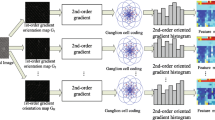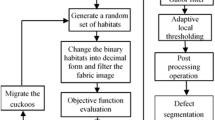Abstract
Gabor filter is a time-frequency combined analysis method, which is suitable for detecting local anomalies in periodic textures. Gabor-based methods mainly include the optimal channel method and multi-channel fusion method. Compared with the optimal channel method, the multi-channel fusion method can obtain more complete image features and has advantages in detecting mixed and isotropic defects. However, the multi-channel fusion method has the problem of feature redundancy and poor anti-noise ability, which reduces the effect of the algorithm. Therefore, a novel fabric defect detection algorithm based on residual energy distribution and Gabor feature fusion is proposed. First, we use a relatively complete bank of Gabor filters to extract the testing and template image features under different channels and calculate the residual energy between them. Then we use the max-to-mean ratio (MMR) metric to measure the saliency of each channel’s defect features and use nonlinear normalization to calculate the weight of each channel. Finally, fuse the multi-channel Gabor features according to the weights. In addition, we optimize the parameters using the signal-to-noise ratio (SNR) indicator and genetic algorithm. Experiments show that the proposed algorithm has advantages over the current state-of-the-art defect detection algorithms.











Similar content being viewed by others
Data availability:
The datasets analyzed during the current study are available in the Tianchi repository, https://tianchi.aliyun.com/competition/entrance/231748/information.
References
Liu, G., Zheng, X.: Fabric defect detection based on information entropy and frequency domain saliency. Vis. Comput. 37(3), 515–528 (2021)
Yang, H., Huang, C., Wang, F., Song, K., Zheng, S., Yin, Z.: Large-scale and rotation-invariant template matching using adaptive radial ring code histograms. Pattern Recognition (2019)
Zhang, Z., Yang, X., Gao, H.: Weighted smallest deformation similarity for nn-based template matching. IEEE Transactions on Industrial Informatics PP(99), 1–1 (2020)
WU Ying, L.L., Jun, W.: Global fabric defect detection based on unsupervised characterization. Journal of Shanghai Jiaotong University (English version) 26(2), 231–238 (2021)
Rasheed, A., Zafar, B., Rasheed, A., Ali, N., Mahmood, M.T.: Fabric defect detection using computer vision techniques: A comprehensive review. Mathematical Problems in Engineering 2020 (2020)
Ng, M.K., Ngan, H., Yuan, X., Zhang, W.: Patterned fabric inspection and visualization by the method of image decomposition. IEEE Trans. Automation Sci. Eng 11(3), 943–947 (2014)
Fabric inspection based on the elo rating method: Pang, Grantham, K., H., Ngan, Henry, Y., T., Tsang, and C. Pattern Recognition: J. Pattern Recognition Soci. 51, 378–394 (2016)
Chang, X., Gu, C., Liang, J., Xu, X.: Fabric defect detection based on pattern template correction. Math. Problems in Eng.,2018,(2018-3-22) 2018(PT.3), 1–17 (2018)
Liu, Li.: Guo, Yulan, Fieguth, Paul, Pietikainen, Matti, Wang, Xiaogang: Local binary features for texture classification: Taxonomy and experimental study. Pattern Recognition:J. Pattern Recognition Soc. 62, 135–160 (2017)
Hu, CS, Min, X, Yun, H, Wang, T, Zhang, SK: Automatic detection of sound knots and loose knots on sugi using gray level co-occurrence matrix parameters. ANN FOREST (2011)
Feng, Li., Lina, Yuan, Kun, Zhang, Wenqing, Li.: A defect detection method for unpatterned fabric based on multidirectional binary patterns and the gray-level co-occurrence matrix. Text. Res. J. 90(7–8), 776–796 (2019)
Feng, L., Xi, Q.G.: Defectnet: Toward fast and effective defect detection. IEEE Transactions on Instrumentation and Measurement PP(99), 1–1 (2021)
Xu, Y., Li, D., Xie, Q., Wu, Q., Wang, J.: Automatic defect detection and segmentation of tunnel surface using modified mask r-cnn. Measurement 178(4), 109316 (2021)
Bao, X., Liang, J., Xia, Y., Hou, Z., Zhan, H.: Low-rank decomposition fabric defect detection based on prior and total variation regularization (2021)
Imamura, A., Arizumi, N.: Gabor filter incorporated cnn for compression (2021)
Li, Y., Zhou, X.: Fabric defect detection with optimal gabor wavelet based on radon. In: IEEE International Conference on Power, Intell. Comput. Syst. (ICPICS), pp. 788–793 (2020)
Li, C., Gao, G., Liu, Z., Huang, D., Xi, J.: Defect detection for patterned fabric images based on GHOG and low-rank decomposition. IEEE Access 7, 83962–83973 (2019). https://doi.org/10.1109/ACCESS.2019.2925196
Zhou, J., Yang, K.: The criteria of choosing the optimal gabor filter and defect detection using the optimal gabor filter. In: International Conference on Intelligent Human-machine Systems & Cybernetics (2015)
Li, Y., Luo, H., Yu, M., Jiang, G., Cong, H.: Fabric defect detection algorithm using rdpso-based optimal gabor filter. J. Textile Institute 110(4), 487–495 (2019)
Cruz, A.C., Bhanu, B., Thakoor, N.S.: Background suppressing gabor energy filtering. Pattern Recognition Letters 52(jan.15), 40–47 (2015)
Amirkhani, A., Karimi, M.P.: Adversarial defenses for object detectors based on gabor convolutional layers. The Visual Computer, 1–16 (2021)
Jing, J., Yang, P., Li, P., Kang, X.: Supervised defect detection on textile fabrics via optimal gabor filter. J. Ind. Text. 44(1), 40–57 (2014)
Kurt, M.: Gensss: a genetic algorithm for measured subsurface scattering representation. Vis. Comput. 37(2), 307–323 (2021). https://doi.org/10.1007/s00371-020-01800-0
Author information
Authors and Affiliations
Corresponding author
Ethics declarations
Conflict of interest
Wenning Qin declares that she has no conflict of interest. Haoran Wen declares that he has no conflict of interest. Feng Li declares that he has no conflict of interest.
Additional information
Publisher's Note
Springer Nature remains neutral with regard to jurisdictional claims in published maps and institutional affiliations.
Rights and permissions
Springer Nature or its licensor (e.g. a society or other partner) holds exclusive rights to this article under a publishing agreement with the author(s) or other rightsholder(s); author self-archiving of the accepted manuscript version of this article is solely governed by the terms of such publishing agreement and applicable law.
About this article
Cite this article
Qin, W., Wen, H. & Li, F. Fabric defect detection algorithm based on residual energy distribution and Gabor feature fusion. Vis Comput 39, 5971–5985 (2023). https://doi.org/10.1007/s00371-022-02706-9
Accepted:
Published:
Issue Date:
DOI: https://doi.org/10.1007/s00371-022-02706-9




